cPanel vs Plesk vs Webmin vs Virtualmin: Which Hosting Panel Is Best?
In most cases, when you pay for hosting you interact with your server through a dedicated control panel. There are a lot of popular web control panels, including cPanel vs Plesk vs Webmin vs Virtualmin. Understanding the differences between each one will help you decide which option is best for your needs.
Usually, you can’t decide which hosting control panel you get to use. That depends on your web host, which will create an account for you on its platform of choice when you sign up for a plan. This means that before you choose a web host, it’s a good idea to know what control panel it offers to its customers.
In this article, we’re going to compare cPanel vs Plesk vs Webmin vs Virtualmin in three essential categories, so you understand what makes each control panel unique.
An introduction to cPanel, Plesk, Webmin, and Virtualmin
In most cases, your web host will offer a single solution for all of its users, with individual accounts to manage their sites. However, if you’re using a server to which you have complete access (such as a VPS or a dedicated server) you can install your hosting control panel of choice.
If you have a preferred control panel, it can also play a role in whether you choose cPanel vs Plesk vs Webmin vs Virtualmin. With that in mind, let’s go over each option.
cPanel

cPanel is one of the most popular hosting control panels on the market. It’s a premium product that’s popular for shared web hosting solutions because it offers scalable plans that can support large numbers of users. However, cPanel also offers solo licenses in case you want to set it up on a server you own.
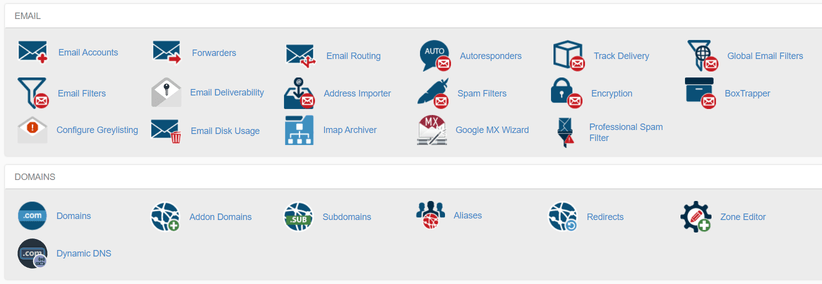
Traditionally, when you access your cPanel account, you’ll see a broad range of tools divided into multiple sections. Among those sections, you have options for software setup, file management, database optimization, and many others.


Plesk

Plesk bills itself as an OS-agnostic hosting control panel. The software offers a user-friendly interface that enables you to manage security settings, set up mail servers, manage databases, create backups, and much more. Plesk is also a WordPress-friendly control panel, as it includes a suite of tools that make it easy to install and update WordPress, and scan your site for vulnerabilities:
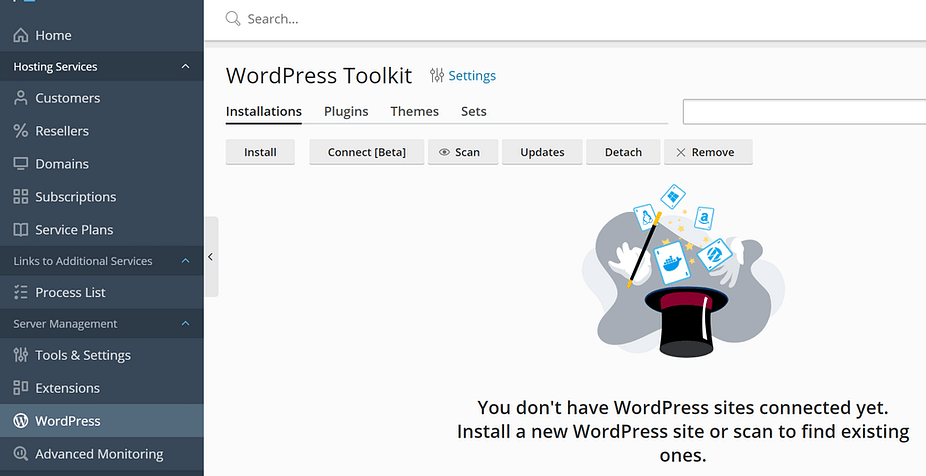
Plesk offers an extension system and a built-in catalog within the control panel. That last feature makes it easy to find approved extensions and set them up with a few clicks. Although most extensions are premium, they tend to be remarkably cheap, with prices starting at around $2.99 per extension per month.


Webmin
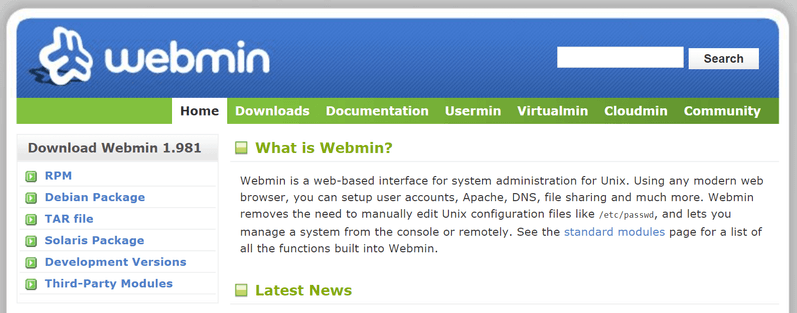
Webmin is open-source software. You can opt to install a full or a “minimal” version of the software, depending on how much control you want over your server. When compared with other control panels, Webmin is by far the most lightweight option in terms of system resources, and its interface is primarily designed for experienced system administrators:
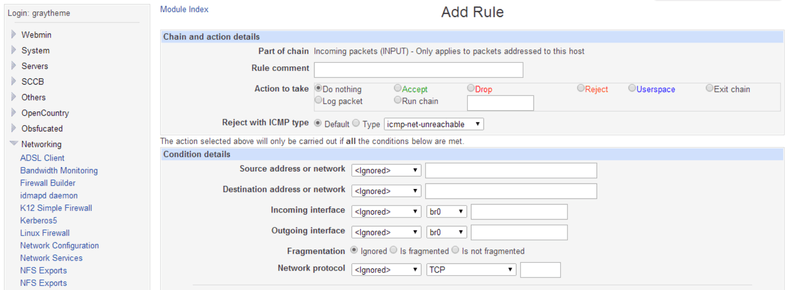
Like other hosting control panels, Webmin supports modules or extensions. You can also use themes to customize the style of your control panel.


Virtualmin

Virtualmin is another open-source hosting control panel that we love, and it’s built on top of Webmin. You can think about Virtualmin as Webmin with a nicer interface, a more robust file manager module, and the ability to switch between the two control panels:
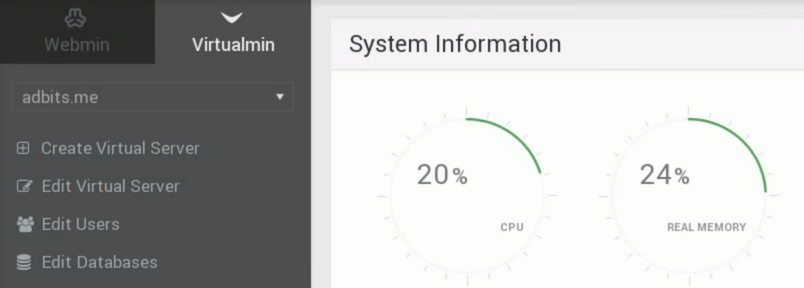
One area where Virtualmin stands out is when it comes to virtual server management. The control panel makes it easy to launch new virtual servers and modify the resources that you allocate to them.
Beyond its virtual server toolkit, Virtualmin also includes all the other features you expect to see in a hosting control panel. With this software, you’ll be able to manage email and databases, set up web applications and CMSs, and more.


cPanel vs Plesk vs Webmin vs Virtualmin: Considerations for choosing the best hosting control panel
Choosing between cPanel vs Plesk vs Webmin vs Virtualmin is not always simple. If you’re using Windows, your choices will be reduced. However, if you’re open to using a Linux installation, your options are wide open.
Aside from your OS, there are other considerations to keep in mind, including performance and security options as well as ease of use. Let’s discuss each of those factors.
1. Performance features
By “performance features”, we mean the tools each hosting control panel offers for configuring and optimizing your server. There are a lot of tools that fall under the performance category, so let’s check out which control panel supports which functionality:
| CPANEL | |
|---|---|
| Database management | Access to phpMyAdmin, a database setup wizard, and support for remote MySQL |
| Email management | Able to set up email accounts, configure forwarding, set filters, and encrypt messages |
| Domain management | Access to a full suite of DNS configuration tools |
| File management | Online file manager, Git support, and FTP management tools |
By and large, every one of the hosting control panels we’ve talked about gives you access to a full set of performance and server configuration tools. The table above covers the basics, but each control panel comes with its own suite of advanced functionality.
When it comes to server management and optimization, cPanel, Plesk, and Webmin are all-around great options. The primary difference between those three panels comes down to ease of use, which we’ll cover in a minute. Out of all four hosting control panels, Virtualmin does stand out due to its suite of virtual server optimization tools.
2. Security measures
A great hosting control panel will provide you with features that enable you to protect your website and server from attackers. Among those features, you have options such as:
- SSH access configuration
- IP whitelisting and blacklisting functionality
- SSL certificate setup
- Two-factor authentication (2FA)
- In-depth activity logs
Both cPanel and Plesk offer all of those features, and they’re easy to find thanks to their user-friendly interfaces. However, Webmin takes the lead here because it gives you far more control over security settings for your server and websites. The downside is that configuring those security settings can be much more complicated than if you’re using cPanel.
Virtualmin also scores well from a security standpoint, as it’s built on top of Webmin. Logs, in particular, are much easier to peruse if you’re using Virtualmin instead of Webmin.
3. Ease of use
Finally, it’s important to consider each web hosting control panel’s ease of use. As far as we’re concerned, Plesk, cPanel, and Virtualmin all offer great user interfaces. Finding the tools you want to use is simple, and configuring them is highly intuitive if you understand what each tool does.
Out of the four options, Plesk offers the slickest interface, but it hides some of its server and website management tools. On the other hand, cPanel won’t be winning any beauty awards, but it doesn’t make you dig around to find the tools you need.
Webmin is the clear underdog when it comes to ease of use. It’s a tool built for users with system administration experience, and it shows. It’s still a viable hosting control panel for many users, but it’s not a beginner-friendly solution.
The best hosting control panels of 2021
Now that you know what makes each hosting control panel unique, it’s time to learn about which hosting providers offer each tool. That way, you’ll be able to decide which web host to use based on its plans, features, and control panel options.
 cPanel
cPanel
As we mentioned easier, cPanel is by far the most popular control panel software, especially among shared web hosts. If you use any of these three hosting providers, you’ll get access to a cPanel setup:
- A2 Hosting: This web host offers affordable prices and a broad range of hosting plans, including WordPress-specific options. If you’re looking for a budget web host with great performance, A2 Hosting is a safe bet.
- HostGator: If you plan on using HostGator, we recommend that you stick with its managed WordPress hosting plans. They offer by far the best performance out of any of HostGator’s services, as well as access to cPanel.
- Bluehost: With Bluehost, you get access to a broad range of plans, including WordPress and WooCommerce-specific options. Bluehost also offers some of the lowest prices for shared hosting.
All three web hosts also offer VPS and dedicated server plans. However, those plans don’t give you access to a free cPanel license. If you plan to use cPanel on a server you own, you’ll need to set it up yourself.
 Plesk
Plesk
Most web hosts don’t offer a Plesk control panel out of the box. However, depending on which provider you use, you may get the option to install Plesk during the server setup process. Here are three web hosts that offer Plesk panels:
- Vultr: This hosting provider offers some of the lowest prices on the market for VPSs. You can launch a VPS for as little as $5 per month, and you can select Plesk during the server setup process.
- Kamatera: With Kamatera, you get access to both regular VPS and managed cloud servers. This provider enables you to choose between multiple control panel options, including cPanel and Plesk.
- Liquid Web: This web host offers dedicated servers and VPSs. It’s definitely not a budget-hosting solution, but one geared towards websites that require top-of-the-line performance. Plus, it has a dedicated partnership with Plesk.
Most VPS providers give you multiple hosting control panel options to choose from. You can also choose to forego a control panel and manage your server using the command line. However, that can make your life a lot more complicated unless you have sysadmin experience.
 Webmin and Virtualmin
Webmin and Virtualmin
Since Virtualmin is based on Webmin, we’re combining hosting recommendations for the two control panels. Most providers don’t offer setup options for either Webmin or Virtualmin. However, since these are open-source software, you’re free to set up either option on your server as long as you meet the system requirements (using an OS it supports).
With that in mind, here are our two hosting recommendations for using Webmin and Virtualmin:
- Joyent: This hosting provider offers managed cloud services and even on-premise solutions. With Joyent, you get help from experts to ensure that your cloud hosting solution is properly set up. It offers both Windows and CentOS servers, which means you can set up either Webmin or Virtualmin as your hosting control panel of choice.
- SSD Nodes: This VPS hosting provider offers high-performance servers, and it enables you to choose between multiple Linux-based operating systems (no Windows option here). That makes it a great option for using either Webmin or Virtualmin.
Installing a hosting control panel manually isn’t as complicated as it might seem, but it does require you to be comfortable using the command line. If you’re not, you’re better off using a web host that supports either cPanel or Plesk.
Conclusion
If you sign up for a shared hosting plan, you won’t get to decide what hosting control panel you get access to. The only thing that you can do in that situation is research what control panel a web host uses before you sign up for one of its plans. That way, you can make the best decision for your needs.
If you’re looking into more advanced plans, you’ll get more control over the hosting panel you use. With a VPS or a dedicated server, for example, you’ll typically be able to set up any option you want. If you’re still not sure which one to opt for, here’s a quick summary of the four hosting control panels:
- cPanel: This is the perfect option if you’re new to using hosting control panels, and it works with Linux setups.
- Plesk: With Plesk, you get to choose between Linux and Windows servers, and the control panel is one of the most user-friendly options available.
- Webmin: This control panel can be a bit intimidating, but it’s incredibly customizable, it’s open-source, and it runs on both Windows and Linux.
- Virtualmin: Although Virtualmin is built on top of Webmin, it stands out due to its suite of virtual server management tools. This particular control panel only runs on Linux setups.
To find hosting to go along with your server control panel, you can browse our roundup of the best web hosting services.
What’s your preference when it comes to cPanel vs Plesk vs Webmin vs Virtualmin? Share your thoughts with us in the comments section below!


Post a Comment